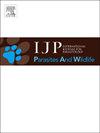鳞片下:在恢复的非洲穿山甲和没收的鳞片上鉴定蜱虫
IF 2
3区 医学
Q3 ECOLOGY
International Journal for Parasitology-Parasites and Wildlife
Pub Date : 2025-07-18
DOI:10.1016/j.ijppaw.2025.101117
引用次数: 0
摘要
穿山甲是全球被贩卖最多的哺乳动物。除了与冠状病毒有关的人畜共患问题外,穿山甲还是蜱虫等体外寄生虫的宿主,这些寄生虫可能通过非法野生动物贸易和康复工作无意中传播。穿山甲及其衍生物的跨大陆贩运构成了影响人类、野生动物和牲畜的病原体溢出的潜在风险。尽管存在这些担忧,但没收的非洲穿山甲和鳞片中蜱虫侵扰的数据仍然很少。本研究旨在利用形态学和分子学方法鉴定与没收穿山甲及其鳞片有关的蜱类。从17只恢复的非洲穿山甲(Smutsia temminckii, Phataginus tricuspis, Phataginus tetradactylus)和9袋查获的鳞片中共收集到275只蜱虫。通过扩增16S rRNA片段并将序列与公开数据进行比较,对代表性标本(n = 53)进行遗传分析。形态学鉴定发现了5种蜱:压迫型双足蜱、黑胸甲蜱、紧凑型鸟蜱、刺头蜱和simus。除“O”外,其余物种的分类鉴定结果均与dna鉴定一致。这导致了O. moubata。这些差异可能是由于两种鸟的形态特征重叠造成的。值得注意的是,来自已确定的三个属的蜱是已知的病原体媒介,可引起诸如心水病、无形体病、巴贝斯虫病、其肠菌病、非洲猪瘟和人类回归热等疾病。我们首次在Phataginus种中记录了A. hebraeum,在P. tetradactyla种中记录了A. compressum,扩大了它们的寄主范围。这项研究还为没收的非洲穿山甲和在非洲内外贩运的鳞甲的蜱虫多样性建立了基线。研究结果强调了综合分类方法在蜱虫鉴定中的重要性,并强调需要进一步的研究,包括额外的遗传标记和形态计量分析,以提高物种分辨率。本文章由计算机程序翻译,如有差异,请以英文原文为准。

Under the scales: Identification of ticks in rehabilitated African pangolins and confiscated scales
Pangolins are the most trafficked mammals globally. Beyond zoonotic concerns related to coronavirus, pangolins serve as hosts for ectoparasites such as ticks, which can be inadvertently transported through illegal wildlife trade and rehabilitation efforts. The transcontinental trafficking of pangolins and their derivatives poses a potential risk of pathogen spillover affecting humans, wildlife, and livestock. Despite these concerns, data on tick infestations in confiscated African pangolins and scales remain scarce. This study aims to identify tick species associated with confiscated pangolins and scales using morphological and molecular approaches. A total of 275 ticks were collected from 17 rehabilitated African pangolins (Smutsia temminckii, Phataginus tricuspis, Phataginus tetradactylus) and nine bags of seized scales. Representative specimens (n = 53) were genetically analyzed by amplifying the 16S rRNA fragment and comparing sequences with publicly available data. Morphological identification revealed five tick species: Amblyomma compressum, A. hebraeum, Ornithodoros compactus, Rhipicephalus theileri, and R. simus. Taxonomic assignments conformed with the DNA-based identification for all species except for ‘O. compactus’ which resulted in O. moubata. These discrepancies may be due to overlapping morphological characters between the two Ornithodoros species. Notably, ticks from the three identified genera are known vectors of pathogens causing diseases such as heartwater, anaplasmosis, babesiosis, theileriosis, African swine fever, and human relapsing fever. We provide the first record of A. hebraeum in Phataginus species, and A. compressum in P. tetradactyla, expanding their host range. This study also establishes a baseline for tick diversity in confiscated African pangolins and scales trafficked within Africa and out of Africa. The findings highlight the importance of integrative taxonomic approaches in tick identification and emphasize the need for further research incorporating additional genetic markers and morphometric analyses to enhance species resolution.
求助全文
通过发布文献求助,成功后即可免费获取论文全文。
去求助
来源期刊

International Journal for Parasitology-Parasites and Wildlife
Medicine-Infectious Diseases
CiteScore
3.80
自引率
5.60%
发文量
113
审稿时长
45 days
期刊介绍:
The International Journal for Parasitology: Parasites and Wildlife (IJP-PAW) publishes the results of original research on parasites of all wildlife, invertebrate and vertebrate. This includes free-ranging, wild populations, as well as captive wildlife, semi-domesticated species (e.g. reindeer) and farmed populations of recently domesticated or wild-captured species (e.g. cultured fishes). Articles on all aspects of wildlife parasitology are welcomed including taxonomy, biodiversity and distribution, ecology and epidemiology, population biology and host-parasite relationships. The impact of parasites on the health and conservation of wildlife is seen as an important area covered by the journal especially the potential role of environmental factors, for example climate. Also important to the journal is ''one health'' and the nature of interactions between wildlife, people and domestic animals, including disease emergence and zoonoses.
 求助内容:
求助内容: 应助结果提醒方式:
应助结果提醒方式:


